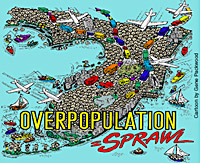Florida Growth – Sources & Symptoms
 Florida's population declined in 2008 for the first time since 1946 as the steep national recession
put the brakes on in-state migration and also saw many residents
fleeing. Florida lost 58,000 residents compared to a year earlier,
as we became the nation's fourth largest state with a population
of 18.7 million people. The number of Floridians lost represents
a city roughly the size of Pensacola, Homestead or Kissimmee.
This information was released by the University of Florida's
Bureau of Economic and Business Research (BEBR) in August 2009.
Florida's population declined in 2008 for the first time since 1946 as the steep national recession
put the brakes on in-state migration and also saw many residents
fleeing. Florida lost 58,000 residents compared to a year earlier,
as we became the nation's fourth largest state with a population
of 18.7 million people. The number of Floridians lost represents
a city roughly the size of Pensacola, Homestead or Kissimmee.
This information was released by the University of Florida's
Bureau of Economic and Business Research (BEBR) in August 2009.
In 2007, according to BEBR, even as the recession began to grip Florida and the nation, the state still gained 126,852 new residents. But those findings were a sharp drop from increases of almost 500,000 residents seen in 2003-2004. Luring out-of-state residents has been Florida's consistent economic plan since the early days of statehood. One of Florida's most robust periods occurred when annual population growth of between 2 % and 2.6% was reported from the mid-19990s through 2006, according to U.F. demographers.
This slow down in rapid growth is not expected to continue. U.F.'s BEBR projects a "growth of about 250,000 a year between 2010 and 2020...". The Legislature's Office of Economic and Demographic Research projects a population of 20 million in Florida, possibly as early as 2015. In the ten years from April 2000-April 2010 we grew by 17.6% to 18,801,310. During those ten years natural increase accounted for 18.4% and net migration topped 81.6%. Those same years saw four counties, Flagler, Sumter, Osceola and St. Johns increase by over 50% while St. Lucie, Lake and Lee counties experienced population growth from 40.3% to 44.2%. http://www.bebr.ufl.edu. (See Too Many Floridians)
Components of Growth
There are only four components of population growth: births, deaths, in-migration and out-migration. Births and in-migration raise the size of a population, whereas deaths and out-migration lower it. The overall growth (or decline) of the population of a given area is thus determined by the number of births, deaths, in-migrants, and out-migrants.
Florida's Growth in the
1990s
Florida has been one of the most rapidly growing states in the nation. According to the 2000 Census, Florida's population was 15,982,378 on April 1, 2000, an increase of 3,044,307 since April 1, 1990. The 1990s was the third consecutive decade in which the Florida population grew by approximately 3 million residents. Florida's absolute population increase during the 1990s was the third largest of any state, trailing only California and Texas. Its percentage increase (23.5 percent) was the seventh highest in the nation.
Florida had more than 1.9 million births and almost 1.5 million deaths during the 1990s. The difference between births and deaths is called "natural increase." Between 1990 and 2000, natural increase in Florida was 448,216 and accounted for 14.7 percent of Florida's total population growth during the decade. The remainder of Florida's growth was caused by net migration (i.e., the excess of in-migrants over out-migrants). Net immigration into Florida was almost 2.6 million during the 1990s and accounted for 85.3 percent of the state's growth. This stands in sharp contrast to the experience in many states, where net migration is small or even negative.
County Trends 1990 to 2000
Every county in Florida experienced an increase in population between 1990 and 2000. More than half of the state's 67 counties grew by more than 25 percent during the decade and 59 grew by more than the national growth rate of 13.2 percent. Five counties grew by more than 60 percent (Flagler, Sumter, Collier, Wakulla, and Osecola), while another five grew by 40-60 percent (Gilchrist, St. John's, Walton, Santa Rosa, and Hendry). These rapidly growing counties are found up and down the Florida peninsula, on both coasts and in the interior of the state. At the other end of the spectrum, only four counties grew by less than 10 percent during the 1990s: Gadsden, Putnam, Pinellas, and Monroe. These counties are also scattered throughout the state, from the Panhandle to the Keys.
In terms of absolute population growth, the largest increases occurred in counties located in southeast Florida. Broward, Miami-Dade, and Palm Beach each grew by more than 267,000 residents during the decade. Four other counties (Orange, Hillsborough, Duval, and Lee) grew by more than 100,000. More than half of the state's population growth occurred in these seven counties. In contrast, twenty-seven counties had increases of less than 10,000 residents during the decade; most of these are in north central Florida and the Panhandle.
A Note About the Data
The population data shown in this report ("Florida Population: Census Summary 2000") refer solely to permanent residents.....Temporary residents such as tourists and snowbirds are excluded from the Florida data, being counted as residents of other states or countries. If they reside in Florida on a permanent basis, persons from foreign countries (except those representing foreign governments) are counted as Florida residents regardless of their legal status. College students, military personnel, and inmates in penal institutions are counted as residents of the cities and counties where they live while in college, the military, or prison, not as residents of their "hometowns."
